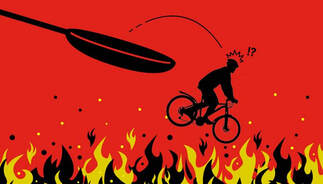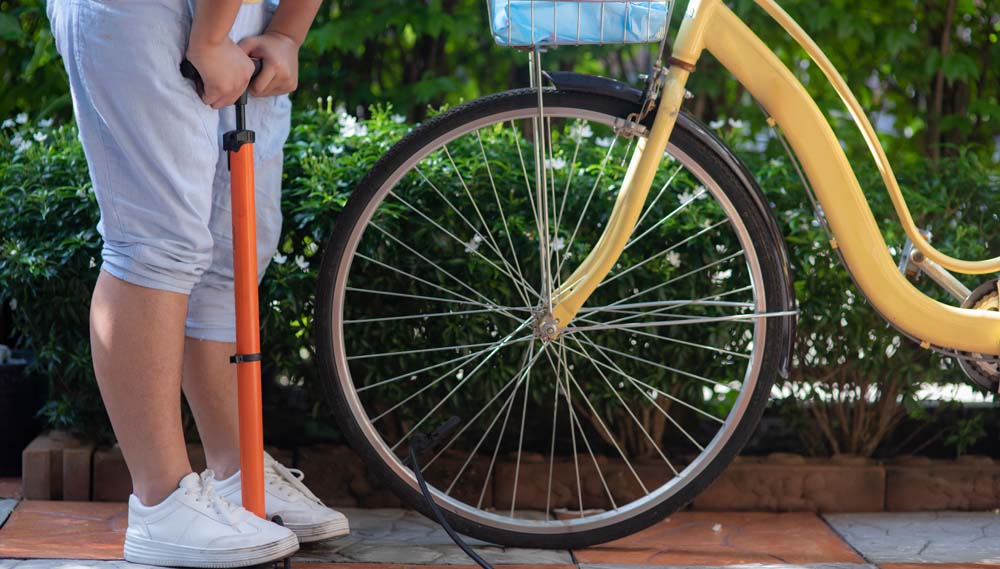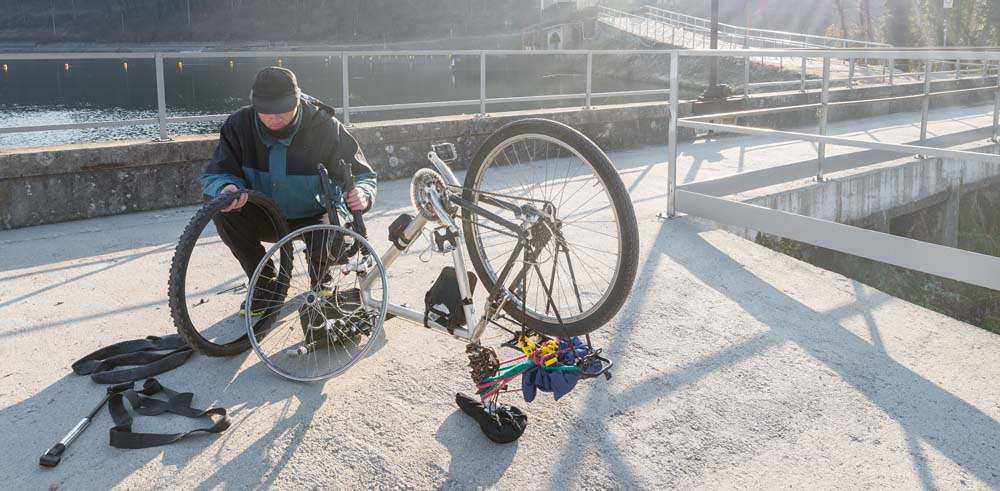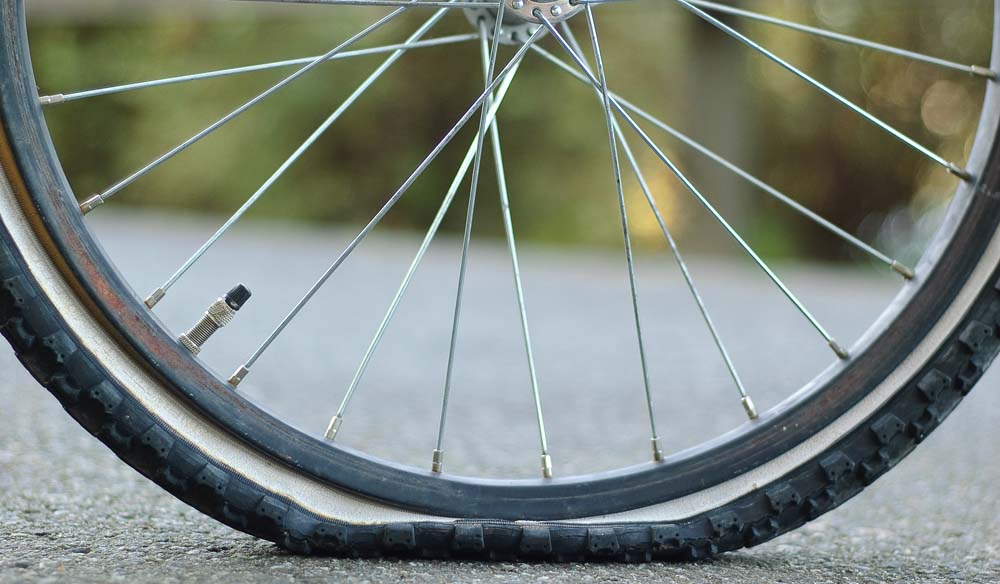 It happens to everyone who rides a bike—you’re rolling along and all of a sudden it becomes hard to pedal, maybe you hear the hissing of air leaving your tires, maybe it’s the loud boom of a blowout. Or you go to get on your bike and discover that a tire is flat because somehow the air leaked out during the night. The result ranges from an inconvenience or it could be dangerous but it is always trouble. Not all flat tires can be prevented but there are simple steps you can take to reduce the likelihood. Flat Prevention Tips Keep Your Tires Properly Inflated Tire pressure is the amount of air in your tire and is measured by pounds per square inch (PSI). You put a pump head on the tire nozzle, and pump it up watching the gauge to the recommended PSI. Every tire has a different recommended PSI and to know what the target PSI is for your tire look on the sidewall of the tire. Sometimes it says the maximum and other times it specifies a range. Skinny road tires are low volume, high pressure, usually 100 PSI or more. Fat mountain bike tires are high volume, low pressure, usually about 35-60 PSI. Hybrid bike tires are in between, between 60 and 80 PSI. While you can sometimes guess what the tire pressure should be, it is best to double check on the sidewall because there are some surprises such as gravel bikes which may look like a road bike, but the tires are lower pressure. Fat tire bikes are usually low pressure, but be sure to check. There are other factors that you should consider to determine the best air pressure for your tire such as rider weight, outside temperature and ride characteristic: 1. Rider Weight -Inflate a little higher the heavier you are, or less if you are lighter, so if you are under 165 pounds, inflate 10 pounds less than if you are over 165 pounds. 2. Temperature – Hot air will make the air in the tube expand beyond it capacity and result in a blowout. In extremely hot environments, reduce the PSI slightly. 3. Riding Characteristics - A tire filled to the high end will provide less traction on the road and cause the ride to be more jarring but will roll faster. One with less air will increase rolling resistance and be harder to pedal but will absorb some of the unevenness in the road surface. In the past very hard tires were the rage, but now with the popularity of fat tire bikes, the trend is to a little softer and more absorbency. When a tire hits an obstacle hard enough, it compresses and bottoms out. The inner tube can get “pinched” between the obstacle and the rim and is noticeable by two small holes in the tubes. This is also called a a pinch flat or snake bite because the two holes look like the wound made by the fangs of a snake. An underinflated tire is more likely to have a pinch flat so even if you want a softer ride, make sure you inflate the tire to at least the minimum pressure. Another undesirable result of a hitting a curb or stone while running underinflated tires is a bend to the rim. A small hole in a tube indicates a slow leak and the bike may still be ridden, but will have to be inflated with air regularly. It is normal for a tube to lose about 3 pounds of air a day but anything more than that indicates a defect in the tube. Since the hole is very small, it may be difficult to find the leak so your best bet is to just replace the tube. Replace Worn Tires Frequent flats might be the result of old and worn tires that can no longer protect your tubes from the pavement. Inspect the tire regularly for areas that are thin, gouged, bald, cracking of the sidewalls, or objects such as glass, stapes, thorns, or nails stuck in the tire. The inside of the tire should not be worn or frayed and there should be no visible cuts inside or outside. Gum wall tires are particularly sustainable to drying out and fraying. If the fabric is torn from the wire bead, it is also time for a new tire. Although a tire may be worn it does not mean it needs to be replaced immediately unless there are visible cuts. Just keep an eye on it for further deterioration. But if you are getting flats, then replace the tire at once. Inspect Wheels Bike wheels themselves can contribute to a flat. Wheels have spokes that fit into the rim with spoke nipples. There might be some sharp areas on the bicycle wheel rim that has contact with the tube that might cause a flat. To prevent a flat check the rim and make corrections before replacing the tube:
Repair Flats Properly Since it is not be possible to prevent every flat, when you do a repair, take the extra time to identify and address the cause. Find the spot on the tube and tire with the hole and make sure any foreign object is removed and any defects in the rim are addressed. There is nothing worse than fixing a flat and then finding it immediately flats again. Be careful when replacing a tube to make sure it is completely inside the tire and not sticking out the sides before inflating. Be sure to use bike tire levers when removing the tire and not screw drivers or sticks that may be too sharp and puncture the new tube. Select the Best Equipment for the Roads You Ride On It used to be that the most popular bikes had light weight skinny, low volume, high-pressure tires and these are still appropriate if you race or ride on smooth surfaces. But today there are more options available from medium to wide tires and different tread patterns. If you ride on rough roads select a wider tire with more rubber. The greater volume of air will resist debris and thicker rubber will make it harder for foreign objects to penetrate and cause a puncture in the tube. Use the correct inner tube for the tire. While it is possible to insert a smaller width tube into a tire since it will expand to fill the space, the rubber of the tube will spread thin increasing the chances of a flat and may shift or break at the value stem. If a tube is too wide it will result in folding over and additional friction. There is equipment available for tires that may help reduce the likelihood of a flat:
Watch for Road Obstacles
The city streets are full of glass, stones, thorns, sticks, metal plates, grates, and rocks and sometimes they are hard to avoid rolling over. Try not to hug the curb because this is where road debris collects and may get stuck in your tires. Cyclists ride on the right side of a road close to the curb where most of the debris accumulates. If you spy a section of debris try to go around it but, for your safety, do not swerve into traffic until you check if the lane next to you is clear. If you have no choice but to bike over a section of debris, stop and check your tires as soon as possible and remove any foreign bodies that may have been embedded in the rubber. If you are riding in a group, point down at hazards and shout a warning as you pass to alert others. Avoid biking over potholes, grates, and metal plates as these surfaces can increase the chance of an impact puncture. Travel around leaves and puddles. If you take these precautions, you can greatly reduce your risk of getting inconvenienced by a flat. Having peace of mind makes a perfect ride even better. Comments are closed.
|
Earth Rider Blog about CycingAuthorSharon Kaminecki and others comment on adventures in bicycling and other stories Categories
All
Archives
August 2023
|





